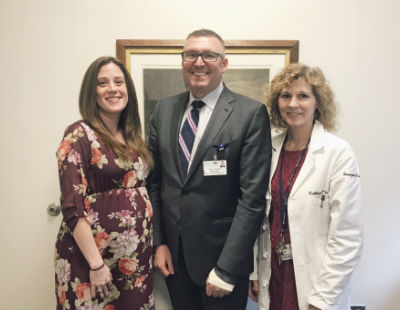
Emergency Medicine leadership celebrate their national recognition: Lisa Triantos, MSN, RN, CEN, NE-BC, nurse manager; Kevin Baumlin, MD, FACEP, chair; and Kathleen Nasci, MD, medical director
Congratulations to the team in Pennsylvania Hospital’s Emergency Department, whose innovative approach to reducing readmissions and connecting patients to follow-up care was recently recognized in Healthcare Business Insights’ Revenue Cycle Academy Journal!
The journal profiles the ED’s development of a plan to address two interwoven challenges: patients who come into the ED are often in need of follow-up care, but if they fail to make it to a follow-up appointment, they are likely to either return to the ED or be readmitted. That’s where a full-time ED scheduler comes in.
The ED scheduler provides personalized navigation services for each patient who arrives in the ED and requires further primary or specialty care by setting up a follow-up appointment for them before they are discharged. If providers order referrals for follow-up care, they go straight into the scheduler’s EHR work queue, and the scheduler takes on the role of liaison between patients, providers, and practices to set an appointment time. Aside from coordinating all of these moving pieces, the ED scheduler also maintains communication with the patient by reminding them of upcoming visits two to three days ahead of time, connecting them with additional resources if necessary, and working with them to remove any barriers that could lead to a missed or cancelled appointment.
“Initiatives like this are not always easy to implement. We are able to break down the barriers, tackle the challenges, and develop a creative approach because it was a team effort,” Kevin M. Baumlin, MD, FACEP, chair of Emergency Medicine. “The successful development of this position – and its replication at HUP and PPMC – is down to the collaboration between nursing leadership, the access center, and staff across disciplines.”
Since this protocol was initially piloted in May 2016, approximately 60 percent of follow-up appointments set by the ED scheduler have been held, with only 18 percent being cancelled and 11 percent ultimately being “no-shows.” Not only has this approach ensured a better experience for patients by connecting them with the care they need at the proper time, but it also closes the readmission loop.
“Our high success rate is highly dependent on the scheduler possessing excellent interpersonal and IT skills, and on their ability to problem-solve and balance variables like whether or not a patient’s insurance coverage will cover care, whether or not they have access to resources like transportation, and other complex factors,” said Lisa Triantos, MSN, RN, CEN, NE-BC, nurse manager of Emergency Medicine. “Because the scheduler builds a relationship with each patient according to their needs, this ensures that the process remains patient-centered.”
